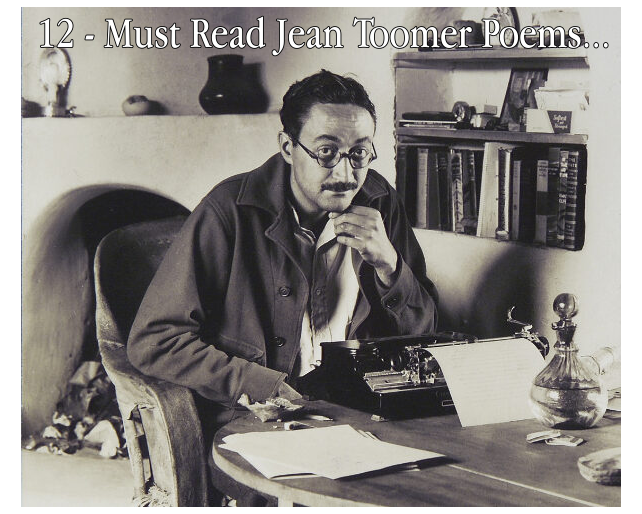(ThyBlackMan.com) Jean Toomer was a profound literary voice of the Harlem Renaissance and one of the most enigmatic poets of his time. Born in Washington, D.C., in 1894, Toomer straddled the lines of race, culture, and identity, crafting works that reflected a deep exploration of the human condition. Though best known for his groundbreaking novel “Cane,” Toomer’s poetry deserves equal recognition for its lyrical beauty and intellectual depth. His works weave themes of race, spirituality, and nature into a rich tapestry that resonates with universal truths. Here are 12 essential poems by Jean Toomer that every lover of literature should explore, along with critiques and insights into why each piece is significant.

1. “Reapers”
“Reapers” is one of Toomer’s most hauntingly vivid poems. In just eight lines, he encapsulates the cold mechanical nature of labor and death. The poem describes black horses pulling a mower through a field, cutting down everything in its path—including a field rat. The imagery is stark and brutal, and the poem’s rhythm mirrors the mechanical, unrelenting nature of the scythe.
Why Read It? “Reapers” offers a commentary on industrialization and the dehumanizing effects of labor, particularly for African Americans. The poem’s brevity and precision make it a masterpiece of economical storytelling. Toomer’s use of sound and visual imagery creates an immersive experience that leaves the reader reflecting on the loss of humanity in an industrial world.
2. “Evening Song”
This poem captures the quiet, intimate beauty of a Southern evening. The speaker reflects on a woman named Cloine, using her as a metaphor for the serene yet elusive qualities of the night. The sensual imagery—”her body is a slim tree” and “her lips are the dusk”—imbues the poem with a dreamlike quality.
Why Read It? “Evening Song” is quintessential Toomer, blending natural imagery with human emotion to create a meditative work. The poem’s ethereal quality invites readers to linger on its lines and feel the South’s languid beauty. It’s a perfect example of Toomer’s ability to bridge the personal and the universal.
3. “Portrait in Georgia”
In “Portrait in Georgia,” Toomer confronts the horrors of racial violence with searing imagery. The poem describes a woman’s beauty juxtaposed with symbols of lynching—”her hair braided like a lyncher’s rope.” The visceral language forces the reader to grapple with the intertwining of beauty and brutality in the American South.
Why Read It? This poem is an unflinching examination of the racial terror experienced by African Americans. Its raw, unapologetic imagery makes it an essential work for understanding the complexities of race and violence in Toomer’s time. The poem’s brevity belies its emotional weight, leaving a lasting impact on the reader.
4. “Georgia Dusk”
A celebration of Southern culture and resilience, “Georgia Dusk” paints a vivid picture of a community coming together at the end of the day. The poem’s lush descriptions of the landscape and its portrayal of folk traditions underscore Toomer’s deep connection to the South.
Why Read It? “Georgia Dusk” showcases Toomer’s ability to blend the spiritual and the earthly. The poem captures the beauty of collective identity and the enduring spirit of African American culture, making it a cornerstone of Toomer’s work.
5. “Harvest Song”
In “Harvest Song,” Toomer delves into the isolation and longing of a laborer. The speaker is a reaper who reflects on his hunger—both literal and metaphorical—and his yearning for connection. The poem’s fragmented structure mirrors the disjointed, weary thoughts of the speaker.
Why Read It? This poem is a poignant exploration of alienation and the human need for community. Its experimental form and evocative language make it a standout piece that showcases Toomer’s modernist leanings.
6. “Nullo”
“Nullo” is a short, evocative poem that uses minimalist language to depict a quiet forest. The poem’s stillness contrasts with the turmoil often present in Toomer’s other works, offering a moment of peace and introspection.
Why Read It? “Nullo” exemplifies Toomer’s skill in creating atmosphere and mood. Its simplicity is deceptive, as the poem invites readers to reflect on the profound silence and beauty of nature.
7. “Conversion”
This poem examines the forced conversion of African slaves to Christianity. Toomer uses stark imagery to convey the loss of cultural identity and the imposition of foreign beliefs. The poem’s tone is one of quiet defiance and sorrow.
Why Read It? “Conversion” is a powerful commentary on cultural erasure and the resilience of the human spirit. It challenges readers to consider the historical and spiritual implications of forced assimilation.
8. “Beehive”
In “Beehive,” Toomer uses the metaphor of bees to explore themes of labor, community, and individuality. The poem’s rhythmic language mimics the buzzing of bees, creating an immersive experience.
Why Read It? This poem is a fascinating study of how individuals contribute to a collective whole. Its rich symbolism and musicality make it a joy to read and analyze.
9. “November Cotton Flower”
“November Cotton Flower” is a celebration of resilience in the face of adversity. The poem describes the unexpected blooming of a cotton flower in November, symbolizing hope and renewal.
Why Read It? This poem is a testament to the endurance of African American culture and spirit. Its uplifting message and vivid imagery make it a standout work in Toomer’s oeuvre.
10. “Song of the Son”
“Song of the Son” is an elegy for the lost traditions of African American culture in the South. The poem’s musical language and nostalgic tone create a sense of longing for a bygone era.
Why Read It? This poem captures the beauty and pain of cultural memory. It’s a moving tribute to the legacy of African American heritage and an essential read for understanding Toomer’s work.
11. “Storm Ending”
“Storm Ending” uses the metaphor of a storm to explore themes of renewal and transformation. The poem’s lush imagery—”the sky, lazily disdaining to pursue / the setting sun” —creates a vivid picture of nature’s power and beauty.
Why Read It? This poem is a masterclass in imagery and symbolism. Its exploration of natural cycles mirrors the human experience, making it a deeply relatable work.
12. “The Blue Meridian”
Though not as well-known as some of his other works, “The Blue Meridian” is a visionary poem that explores themes of unity and spiritual transcendence. The poem’s expansive scope and ambitious language make it a standout piece in Toomer’s repertoire.
Why Read It? This poem offers a glimpse into Toomer’s spiritual philosophy and his vision for a unified humanity. Its complexity and depth make it a rewarding read for those willing to engage with its ideas.
Jean Toomer’s poetry is a treasure trove of insight, emotion, and artistry. His ability to blend modernist techniques with themes of race, identity, and spirituality makes his work both timeless and relevant. These 12 poems offer a comprehensive introduction to Toomer’s genius, showcasing his range and the enduring power of his voice. For anyone seeking to understand the complexities of the human experience through the lens of poetry, Jean Toomer’s work is essential reading.
Staff Writer; Jamar Jackson
This brother has a passion for poetry and music. One may contact him at; JJackson@ThyBlackMan.com.
















Leave a Reply